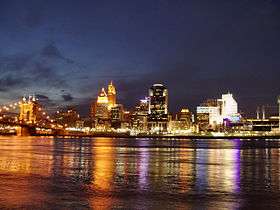Nicknames of Cincinnati

Cincinnati has many nicknames, including Cinci, "The Queen City,"[1] "The Queen of the West,"[2] "The Blue Chip City,"[3][4][5] and "The City of Seven Hills,"[6] These are more typically associated with professional, academic, and public relations references to the city, including restaurant names such as Blue Chip Cookies, and are not commonly used by locals in casual conversation.
The classic nickname "Queen City" is taken from the 1854 poem Catawba Wine. In it, Henry Wadsworth Longfellow wrote of the city: "And this Song of the Vine, This greeting of mine, The winds and the birds shall deliver, To the Queen of the West, In her garlands dressed, On the banks of the Beautiful River."[7] In the 1840s and 1850s, Cincinnati was the largest US city not located on the Atlantic Ocean or Gulf of Mexico.
Cincinnati for many years was known as "Porkopolis", a name perhaps not much coveted by the citizens of the Queen City but justified possibly by the large pork interests centered here for several decades.[8]
Newer nicknames such as "The 'Nati" are emerging and are attempted to be used in different cultural contexts such as the "hip-hop" scene and more casual settings. For example, a local litter-prevention campaign uses the slogan "Don’t Trash the 'Nati."[9]
Some, particularly those of older generations, still use a regional pronunciation of the city's name where the final vowel ("I") is short as opposed to long. Phonetically, this variation would be spelled [sin-suh-nat-uh] instead of the generally accepted [sin-sin-nat-ee]. This has seen less usage in recent years.
The nickname, "The City of Seven Hills," is not now a literal description of the city, as there are many more than seven hills in modern Cincinnati. When the city was younger and smaller, the June 1853 edition of the West American Review, "Article III--Cincinnati: Its Relations to the West and South" described and named seven specific hills. The hills form a crescent around the city: Mount Adams, Walnut Hills, Mount Auburn, Vine Street Hill, College Hill, Fairmont (now rendered Fairmount), and Mount Harrison (now known as Price Hill). The name refers to ancient Rome that is reputed to be built on seven hills.
See also
References
- ↑ Close to home: Across the region, dozens of sites have historic ties to the Underground Railroad, Cincinnati Enquirer, Sunday, August 15, 2004, "The poet Longfellow, recognizing the town's rising stature, immortalized Cincinnati as the "Queen City of the West." accessed 2008-05-03
- ↑ "Frequently Asked Questions about Cincinnati, Ohio".
- ↑ "Cincinnati: many discounters say it's a 'blue chip' investment". Discount Store News. 1988.
- ↑ Lawley, Lauren (1998-07-17). "Cookie firm swallows parent: The local Blue Chip Cookies franchisee is buying the company's San Francisco franchiser". Cincinnati Business Courier. American City Business Journals. Retrieved 2008-05-03.
In 1984, the Greater Cincinnati Chamber of Commerce began its 'Blue Chip City' campaign, a marketing strategy it continued through last year.
- ↑ Great cities test: How does Cincinnati stack up to its regional rivals?, Cincinnati Enquirer, Sunday, March 11, 2001 "Cincinnati's dated “Blue Chip City” nickname is being replaced with “Let the spirit move you.” To where?" accessed 2008-05-03
- ↑ "Ups and downs: The hills are alive, but don't try counting".
- ↑ http://library.cincymuseum.org/cinfaq7menu.htm
- ↑ Clark, S. J. (1912). Cincinnati, the Queen City, 1788-1912, Volume 2. The S. J. Clarke Publishing Company. p. 334. Retrieved 2013-05-20.
- ↑ "Don't Trash the 'Nati"., Keep Cincinnati Beautiful website, accessed May 3, 2008